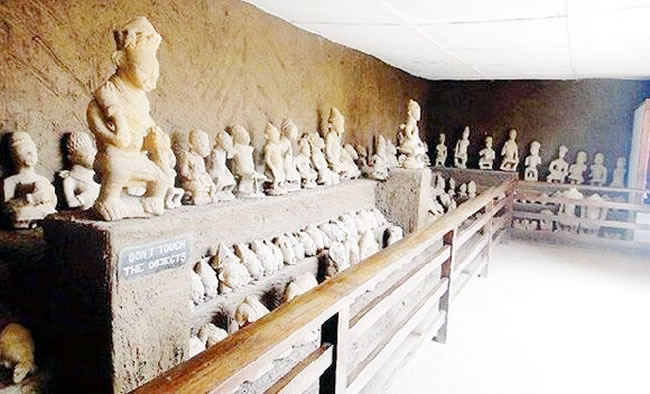In this piece, BIOLA AZEEZ reports the present state of Nigeria’s first museum, and the growing appeal for patronage and funding.
Esie Museum, located in Irepodun Local Government Area of Kwara State, established in 1945, is Nigeria’s first musseum. The national museum houses the largest stone images in Sub-Saharan Africa. The soapstone images were said to have been discovered by members of Esie community in 1775, while the museum is located around the vicinity where the images were originally found. The place has been attested to as a world-class tourist attraction.
The Nigerian Tribune gathered that members of the community worshipped the stone images when they were discovered to have been buried around a tree. Thus, the location of the Esie museum is both strategic and symbolic.
The museum, which now has both old and modern galleries, houses more than 2,000 images and objects. The old gallery has a collection of soapstone images with artistic depiction of human beings, and their origin remains a mystery till date. The old gallery houses between 1,000 to 1,500 stone images, while the modern gallery has over 500.
The stone images, according to history, were said to have been discovered by someone who migrated from old Oyo to where the museum presently stands. The migrant, a famous hunter known as Baragbon, reportedly made the discovery during one of his hunting expeditions.
“When Baragbon discovered this place, he went back to inform his people and they consulted Ifa (oracle) to ascertain whether they were humans, and Ifa confirmed they were human beings that turned to stones because of their evil intentions and disobedience to the Supreme Being. The people worshipped them until 1933 when an European missionary, who was an education inspector to the area, saw them and reported their existence to the then colonial governor. Thus, the museum was established in 1945,” a resident said.
An article in the museum states that the stones are not former humans, but carvings.
“The images are man-made carvings by the people. But no successful effort has been made to identify the supposed carvers to support the claim that the images are carved objects. And the Esie community has no historical antecedence as stone carvers,” the article reads.
Leo Frobenius, a German traveler and anthropologist, was said to have visited the site in 1912, and was amazed to discover a collection of stone carvings of men and women, musical instruments, household utensils, guns and cutlasses.
The site was later developed into a museum for tourist attraction in 1945, and it became the forerunner of other museums in the country being managed by the National Commission for Museums and Monuments (NCMM).
Another article by the museum titled, ‘The Mystery of Esie Soapstone Sculptures’, states that Esie museum was formerly a grove.
“Esie Museum is sited at the spot where the sculptures were discovered about 14km southwest of Esie township. Esie itself is located about 50km southeast of llorin along the llorin/Kabba road. The Museum was established in 1945 by the Colonial Government to house the soapstone sculptures that were brought to limelight in 1933 by H.G. Ramshaw, a School Inspector.
“Esie Museum contains over 1,000 carvings of men and women presided over by a king (Oba Ere).
“Though some of the objects were partly buried, however, it would be misleading to say that all sculptures were dug out from the ground. They were found amassed in semi-circular pattern.
“The sculptures belong to one of the largest collections of stone carvings in Africa. They range in height from 14cm to over one metre and weigh up to 104 kilograms. Esie sculptures depict human beings and, in a few cases, animals.
“They represent people engaged in different activities such as laughing or playing musical instruments. Facial marks are prevalent though some of the heads are plain-faced. Many of the figurines are carved in sitting positions and steatite is the major rock type used as raw material.
“Some statues have deep cuts on the face and upper body, possibly due to willful damage or by accident. Though some commoners are represented, most of the objects depict rich attires, beads and well-designed headgears,” it stated.
According to Esie tradition, the statues are remains of visitors and are said to hold some powers as making barren women to bear children and causing rainfall.
Excavations
In 2008 and 2009, excavations on several sites were carried out by archaeologists from the NCMM and the University of lbadan. The deposits comprised fragments of soapstone figurines and other archaeological materials. Present-day inhabitants of Esie claim to have met the objects when they migrated to their recent site in 1775 AD.
Another approach was the thermoluminiscence dating of a terracatta fragment, found associated with soapstone sculpture by P. Stevens (1977) and which gave a date of 1100 AD. Radio-carbondating provided a similar date between the 10th and 11th century AD (Onabajo 1988).
Visitors to the museum
Visitors come to the museum from all parts of the federation, especially from the South-West. These include schoolchildren and people who come to the area for social events. The Esie Monument Festival also generates more audience for the soapstone sculptures.
Since the community believed that the sculptures had powers, people worshipped the sculptures in the form of a festival each year to thank them for their protection during the past year and pray for prosperity in the coming one. It was believed that if the objects were properly appeased, they would protect the people and bring progress and prosperity to the community. The worship was said to take place around the beginning of the rainy season.
However, in the last two decades, the worship of the stones ceased and has been replaced in the last five years by a festival.
It was gathered that over the years, the percentage of tourists to the site has not been very encouraging as only a few people have visited recently.
Students of tertiary institutions in and outside the country, who are doing their term papers/projects on Esie museum, form part of the population that make use of the national monument. They also make copies of their works available to the museum as reference materials.
The curator of the Esie national museum, Mr. Johnson Ajayi, would not speak with the Nigerian Tribune, except there was an approval from NCMM.
He said: “We have been instructed not to give information or allow taking of pictures any longer. There’s a need to get approval from Abuja headquarters. Before, it was free. The authority thinks that if we can’t retrieve our national artefacts outside the country, we should jealously guard and protect those we have so that we would have something to pass on to coming generations.
“These traffickers are dangerous and can do anything. Thus, the need to protect our heritage. You know the FESTAC sculpture was stolen and the white people are saying that Nigeria should pay a lot to retrieve it from the UK museum. They say our climate is not conducive for the artefact. You can imagine! So, somebody was commissioned to do a replica of the FESTAC image which we have now to show to our young ones.”
Mr. Samuel Alabi, a stakeholder in the area, spoke on why the museum has recorded low patronage.
He said: “We don’t value leisure in this clime. When our people are on leave, they engage in one work or another. Even when they go on retirement, they still find it difficult to rest. Rather, they have time to chase after money. And that’s one of the reasons for short lifespan.
“A German, who visited here (Esie museum) about two weeks ago, said he had been saving money for his trip to visit this place in the past three years. He said he read about the nation’s first museum and was eager to come and visit to spend his leave/vacation. He came all alone.
“But here, we chase after mundane and material things. A country like Kenya or Tanzania has 90 per cent of revenue generated from tourism, but our leisure here is visiting bars to drink, instead of taking your family to a hotel and allowing cooks to prepare your meal and relax. Interestingly, our government and the economic realities do not present a conducive environment for such.”
Also, the Nigerian Tribune gathered that due to low funding, the last time management of the Esie museum organised a children fiesta was Children’s Day celebration in 2013.
Meanwhile, a commercial motorcycle operator at the Oro town motor park, Mallam Sakirudeen Owolabi, who takes visitors to the museum from the park, said the museum has visitors from time to time.
He said: “Visitors do come here. One person has visited today. Students from primary, secondary and tertiary institutions are the main visitors to the Esie museum, especially for their excursion programmes. Also, people do come during festivals, be it Christian or Muslim festivities. But for ordinary people to just come around for tourism? That’s far from it. What will I come here to do?”
Another resident of the area, Mrs. Veronica Abejide, said: “People come to visit, especially with this newly constructed road. Unfortunately, the negative impact of COVID-19 on the people’s socioeconomic lifestyle has made the place to look scanty, quiet, and large gatherings have also been discouraged.
“For instance, staff members of the museum from level 12 downwards have been directed to work from home.
“More so, if you’re familiar with the ethno-religious setup of Kwara State, you will know that both Kwara North and Kwara South senatorial districts are Muslim-dominated areas inhabited by such tribes as Yoruba, Nupe, Baruten and others. Kwara South senatorial district, where the Esie museum is located, is predominantly Yoruba and thus the people are familiar and can relate with the history behind the origin of the museum, unlike other people.”
French Ambassador to Nigeria, Jerome Pasquire, visited the tourist site in June in the company of Abdulrahman Abdulrazaq, governor of Kwara.
Speaking after the visit, he said: “I am very happy to be here. I have never heard of Esie museum before. It is really a wonderful discovery. It is a world-class museum, which deserves to be well known across the world.
“I shall try to inform many people from France and I can advise them to come here to see this museum.
“Even with the new three kilometres road that the governor just commissioned, it will help people to come and see this museum. It is very unique in this region and even in the world. It can be a world-class tourist attraction in Kwara.”
Governor Abdulrazaq, on his part, explained that the construction of the Esie museum road in Irepodun Local Government Area was part of the administration’s integrated approach to bring socioeconomic and cultural development and make Kwara the new investment destination.
“National Museum Esie is a Federal Government project. What we have done is to construct a new road leading to it. This will also encourage more people to visit and open the economic space. We will be working with the Federal Ministry of Information and Culture under Alhaji Lai Mohammed to make sure the right infrastructure is put in place and existing facilities upgraded.
“This is the first museum in Nigeria and from today, it will be more known that Esie is on the global map. That is the whole idea.
“Our vision and commitment for a greater Kwara is clear. And we will seek out every strategic friendship, especially from the private sector and development partners, to achieve our goals,” he said.
Speaking on the importance of the museum, the senator representing Kwara South district, Lola Ashiru, during a recent visit to the museum, advocated conversion of the museum to a university of history and archaeology, to promote culture and tourism.
He said: “Esie images and museum in the Ifelodun Local Government Area of Kwara State is where we have stone artefacts hewed out of the ground dating back to the 10th century. It is like a history book of people of the area. This is to show the prosperity of the people of Esie, Igbomina and Kwara South in general. This is to show their prowess in the 10th century. This is to show that in the 10th century, our people living here were engaged in agriculture, commerce, culture and social life,» the lawmaker said.
The lawmaker, who also spoke on the need to encourage the study of culture to save it from going extinct, described cultural tourism as an important aspect of life.
He, therefore, called on governments at all levels to collaborate with private investors to invest in tourism in Kwara South senatorial district for cultural and economic development.
YOU SHOULD NOT MISS THESE HEADLINES FROM NIGERIAN TRIBUNE
Lagos Is Second Least Liveable City In The World For 2021
Lagos is the second least liveable city in the world for the year 2021. This is according to the most recent annual ranking put together by the Economist Intelligence Unit (EIU)…
CLAIM 1: A Twitter user claims UNICEF said any efforts to block children from accessing pornography might infringe their human rights.
WATCH TOP VIDEOS FROM NIGERIAN TRIBUNE TV
- Let’s Talk About SELF-AWARENESS
- Is Your Confidence Mistaken for Pride? Let’s talk about it
- Is Etiquette About Perfection…Or Just Not Being Rude?
- Top Psychologist Reveal 3 Signs You’re Struggling With Imposter Syndrome
- Do You Pick Up Work-Related Calls at Midnight or Never? Let’s Talk About Boundaries







